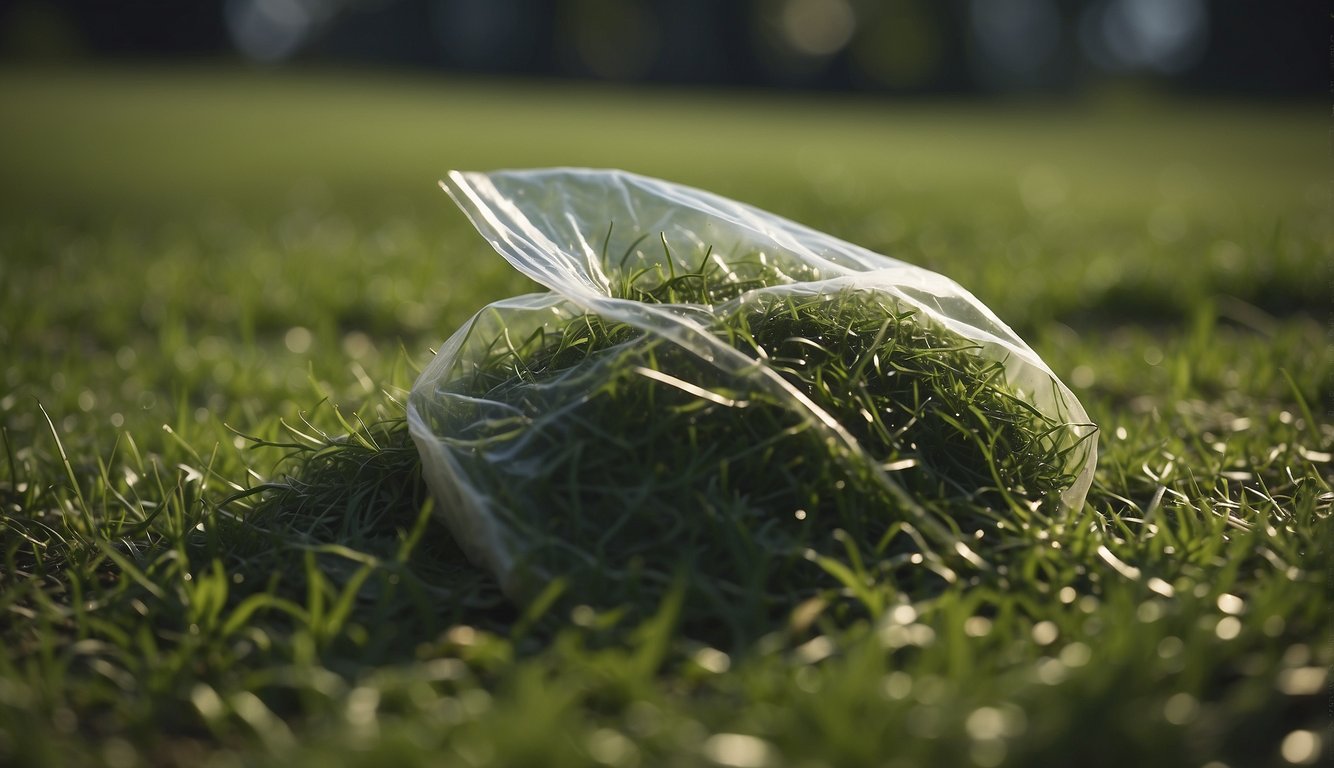TheHerbProf.com is a treasure trove of knowledge for those interested in natural healing and herbal remedies. The website is run by Paul Johnston MD. A naturopathic who has not only received extensive education in the field but also has personal experience in self-healing.
How to clean up grass clippings? Cleaning up grass clippings is an essential part of lawn care. Leaving grass clippings on the lawn can provide valuable nutrients to the soil, but too many clippings can cause problems. Excess clippings can create thatch, which can prevent water and nutrients from reaching the roots of the grass. Additionally, grass clippings can be unsightly and create a mess on the lawn.
To clean up grass clippings, there are several methods you can use. One of the easiest ways is to use a rake or leaf blower to remove the clippings from your lawn. This method is effective, but it can be time-consuming. If you have a large lawn, you may want to consider using a lawn sweeper or bagging attachment for your mower.
Another option is to mow your lawn more frequently and leave the clippings on the lawn. This method can be beneficial for your lawn, as the clippings can provide valuable nutrients to the soil. However, it is important to avoid leaving too many clippings on the lawn, as this can create thatch and other problems. If you do choose to leave clippings on the lawn, be sure to mow your lawn when it is dry, as wet grass clippings can clump together and create a mess.
Understanding Grass Clippings
As a homeowner, it is essential to understand the composition and benefits of grass clippings as well as the challenges that come with them. Here, I will provide an overview of these aspects to help you make informed decisions on how to manage your lawn clippings.
Composition and Benefits
Grass clippings are the result of mowing your lawn. They are made up of organic matter, which is rich in essential nutrients such as nitrogen, phosphorus, and potassium. These nutrients are beneficial to your lawn, as they promote healthy growth and development. When left on the lawn, grass clippings decompose and release these nutrients back into the soil, providing a natural fertilizer for your lawn.
In addition to providing nutrients, grass clippings also help to retain moisture in the soil, which is essential for maintaining a healthy lawn. They act as a natural mulch, reducing soil erosion and preventing weed growth.
Challenges with Clippings
While grass clippings offer many benefits to your lawn, they can also pose some challenges. One of the most significant challenges is thatch buildup. Thatch is a layer of dead grass, roots, and other organic matter that accumulates on top of the soil. When grass clippings are left on the lawn, they can contribute to thatch buildup. However, this is only a problem if the clippings are excessive.
Another challenge is the appearance of your lawn. If you leave grass clippings on your lawn after mowing, they can make your lawn look messy and unkempt. This can be an issue if you have an HOA or if you want your lawn to look pristine.
Grass clippings are a valuable resource for your lawn, providing essential nutrients and promoting healthy growth. However, they can also pose some challenges, such as thatch buildup and an unkempt appearance. Understanding these aspects can help you make informed decisions on how to manage your lawn clippings.
Lawn Mowing Techniques
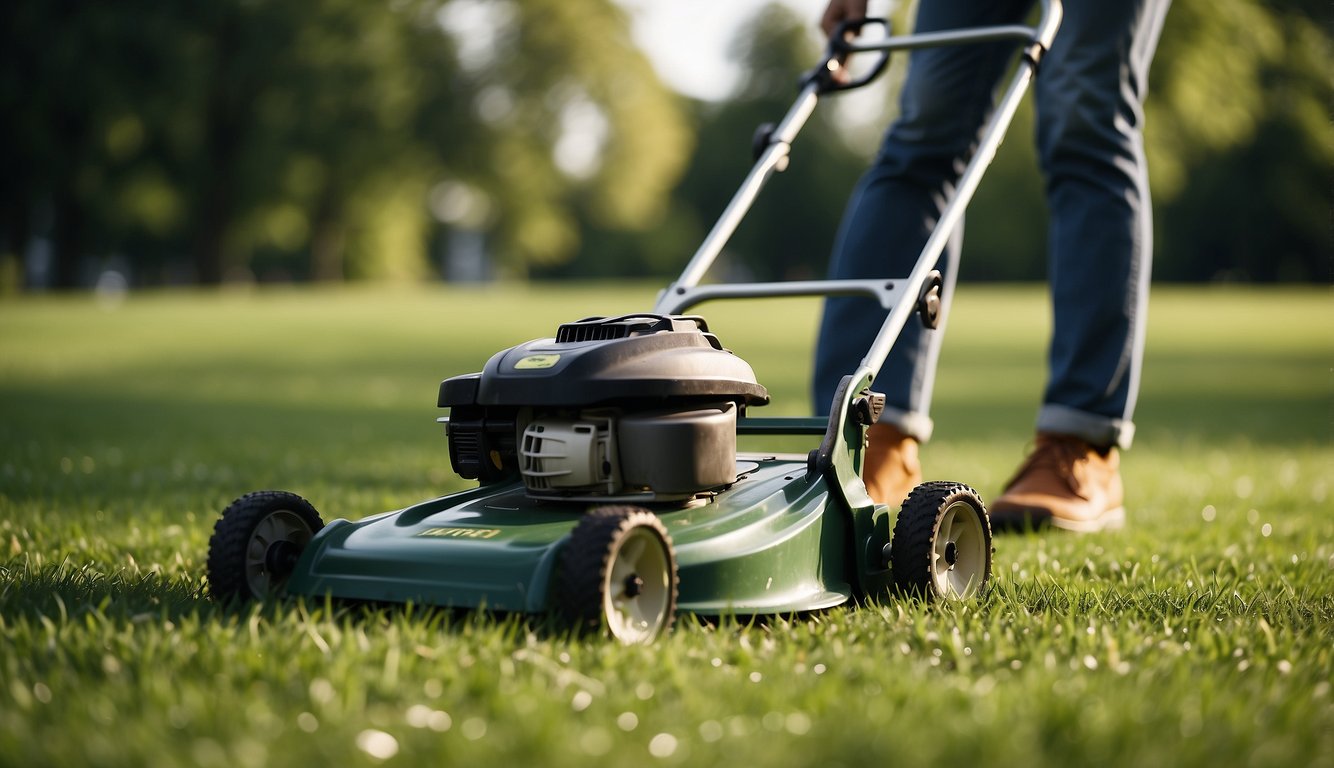
As someone who has been mowing lawns for years, I have learned that there are a few techniques that can make cleaning up grass clippings much easier. Here are some tips that I have found to be helpful:
Adjust Mowing Height – How to Clean Up Grass Clippings?
One of the most important things you can do to make cleaning up grass clippings easier is to adjust the height of your lawn mower. If you set your mower too low, you will end up cutting the grass too short, which can lead to clumping and an uneven lawn. On the other hand, if you set your mower too high, you won’t be cutting the grass short enough, which can also lead to clumping.
Alternate Mowing Patterns
Another technique that can help make cleaning up grass clippings easier is to alternate your mowing patterns. If you always mow in the same direction, you will end up pushing the grass clippings in the same direction every time, which can lead to clumping. By alternating your mowing patterns, you can help prevent clumping and make it easier to clean up the clippings.
Frequent Mowing
Finally, one of the best ways to make cleaning up grass clippings easier is to mow your lawn frequently. If you wait too long between mowings, the grass can get too tall, which can lead to clumping. By mowing your lawn frequently, you can keep the grass at a manageable height and make it easier to clean up the clippings.
By following these lawn mowing techniques, you can make cleaning up grass clippings much easier. Just remember to adjust your mowing height, alternate your mowing patterns, and mow your lawn frequently to prevent clumping.
Grass Clipping Collection and Disposal – How to Clean Up Grass Clippings?
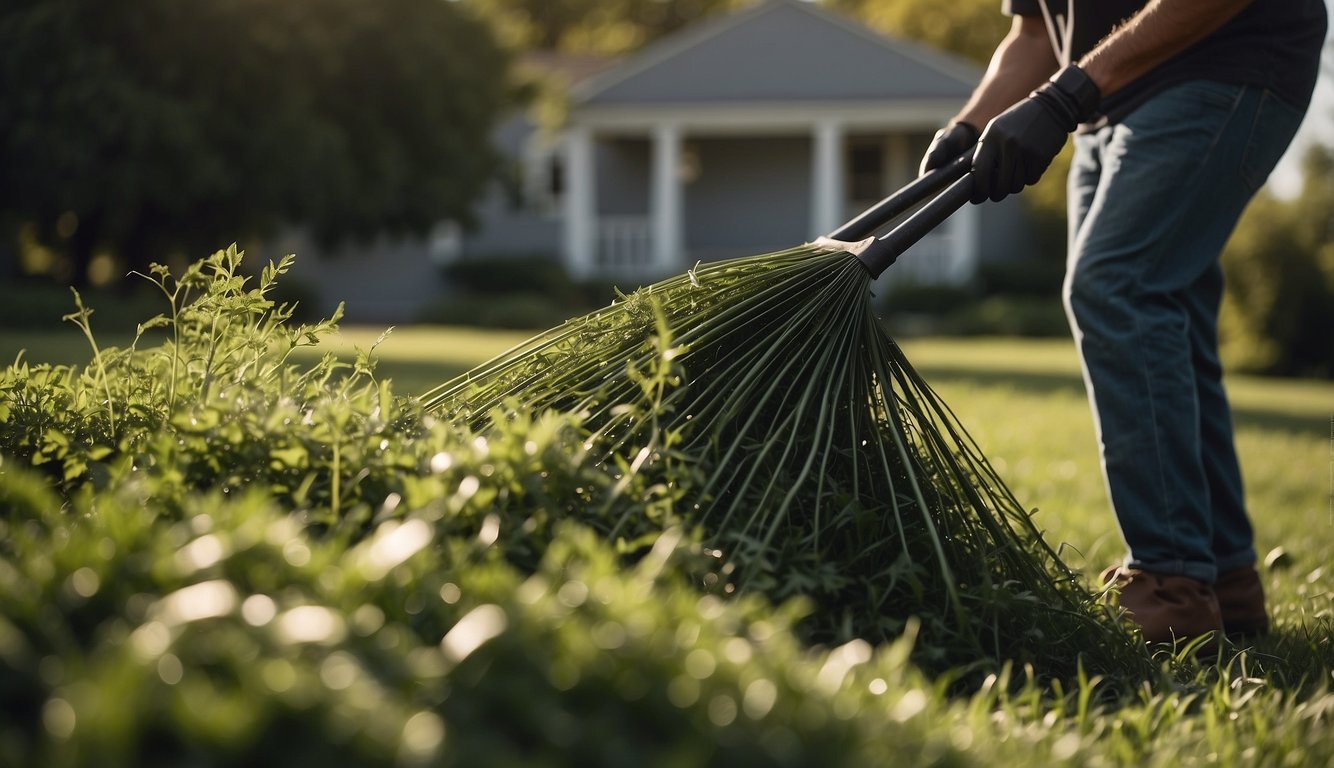
As a lawn owner, one of the essential tasks you have to do is clean up grass clippings after mowing. There are several ways to do this, and in this section, I will go over the most common methods.
Bagging Clippings
One of the most straightforward ways to dispose of grass clippings is by bagging them. You can use a bagging attachment to your lawn mower to collect the clippings as you mow. Once the bag is full, you can empty it into a compost bin or dispose of it in the trash. Bagging clippings is an efficient way to keep your lawn clean and tidy.
Using a Rake or Leaf Blower – How to Clean Up Grass Clippings?
If you don’t have a bagging attachment for your lawn mower, you can use a rake or leaf blower to collect the clippings. Raking is a great option if you have a small lawn, while a leaf blower is more suitable for larger lawns. Raking and using a leaf blower can be time-consuming but are effective ways to clean up grass clippings.
Curbside Pickup
If you live in an area that offers curbside pickup, you can bag your grass clippings and leave them on the curb for pickup. Some cities have regulations on how to dispose of lawn clippings, so make sure to check with your local government before leaving your clippings on the curb.
Cleaning up grass clippings is an essential part of lawn maintenance. You can bag the clippings, use a rake or leaf blower, or leave them on the curb for pickup. Choose the method that works best for you and keep your lawn looking neat and tidy.
Composting Grass Clippings – How to Clean Up Grass Clippings?
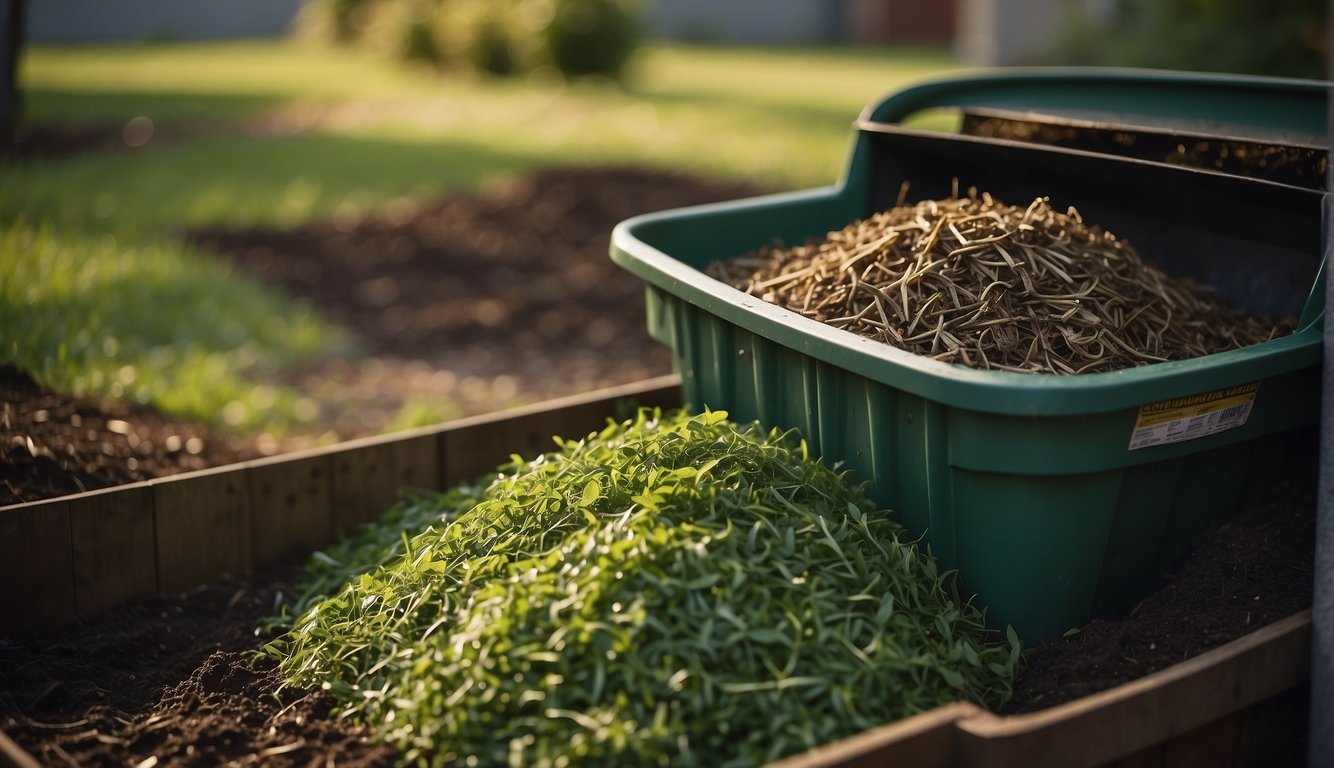
As a gardener, I know that grass clippings can be a valuable resource when it comes to composting. Grass clippings are rich in nitrogen, which is an essential nutrient for healthy plant growth. By composting grass clippings, you can create a natural fertilizer that will help your garden thrive.
Setting Up a Compost Bin
Before you can start composting grass clippings, you need to set up a compost bin. You can buy a compost bin at your local garden center or make one yourself. A compost bin should be at least 3 feet wide, 3 feet deep, and 3 feet tall. It should also have a lid to keep out rainwater and pests.
Composting Process – How to Clean Up Grass Clippings?
To compost grass clippings, you need to mix them with other organic materials, such as leaves, twigs, and food scraps. You should aim for a ratio of 3 parts brown materials (leaves, twigs) to 1 part green materials (grass clippings, food scraps). This will ensure that your compost pile has the right balance of carbon and nitrogen.
It’s important to keep your compost pile moist, but not too wet. You can add water to your compost pile as needed to keep it moist. You should also turn your compost pile regularly to ensure that it decomposes evenly. It can take anywhere from a few weeks to several months for your compost to be ready to use.
Using Grass Clippings as Mulch
If you don’t have a compost bin or don’t want to compost your grass clippings, you can use them as mulch instead. Grass clippings make an excellent mulch because they help retain moisture in the soil and suppress weed growth. To use grass clippings as mulch, simply spread a layer of grass clippings around your plants. Be sure to keep the layer of grass clippings thin (no more than 2 inches) to prevent them from smothering your plants.
Composting grass clippings is a great way to create a natural fertilizer for your garden. By setting up a compost bin, mixing your grass clippings with other organic materials, and keeping your compost pile moist and turned, you can create a rich, nutrient-dense compost that your plants will love. Alternatively, you can use grass clippings as mulch to help retain moisture in the soil and suppress weed growth.
Lawn Health and Fertilization – How to Clean Up Grass Clippings?
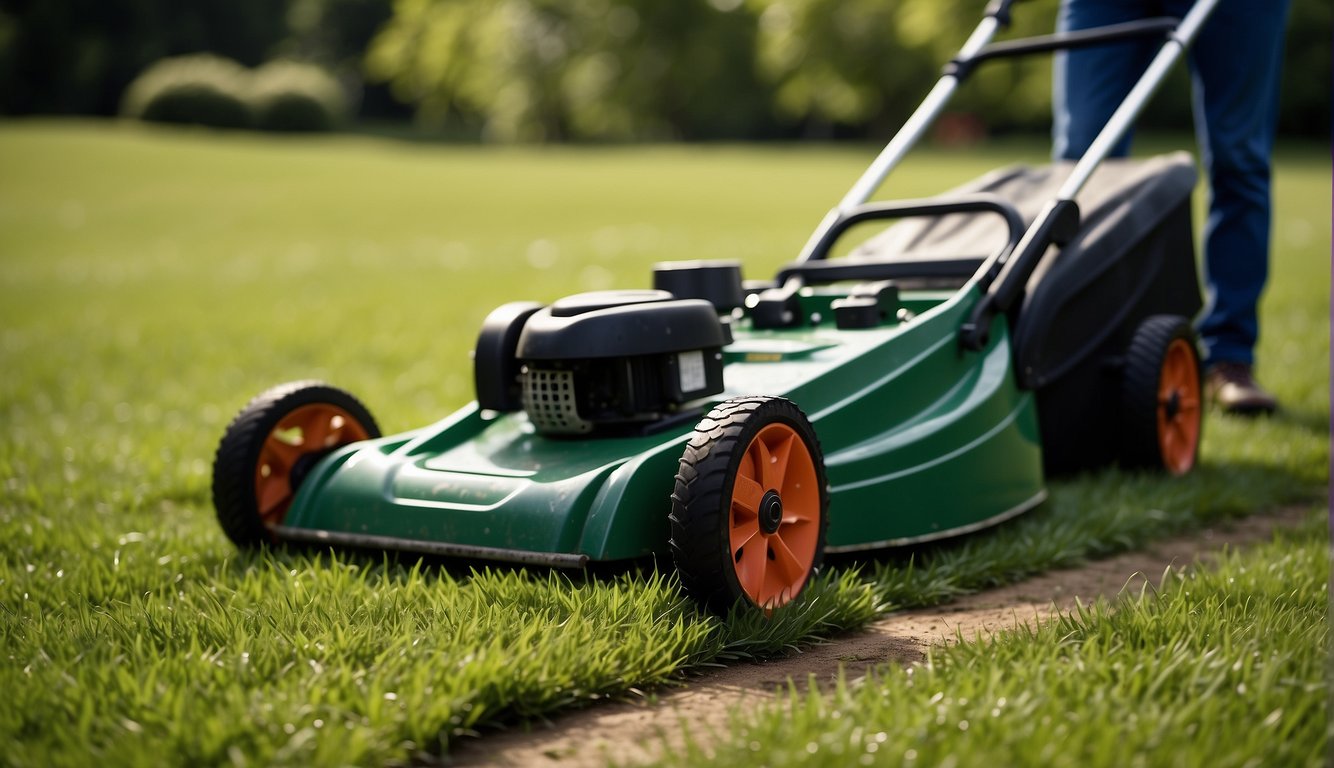
As a lawn owner, I understand the importance of maintaining a healthy and lush lawn. Proper fertilization is one of the key factors in achieving this goal. Grass clippings can be a valuable source of nutrients for your lawn. In this section, I will discuss how to utilize grass clippings to promote lawn health and fertilization.
Nutrient Recycling with Clippings
Grass clippings are rich in nutrients such as nitrogen, phosphorus, and potassium. By leaving grass clippings on the lawn after mowing, you can recycle these nutrients back into the soil. This process is known as nutrient recycling. According to Bob Vila, grass clippings left on the lawn can act as a natural fertilizer, providing nutrients to the grass as they decompose. This can reduce the amount of fertilizer required to maintain a healthy lawn.
Fertilizer Needs and Application
While grass clippings can provide some nutrients, they may not be enough to meet the fertilizer needs of your lawn. It is important to determine the fertilizer needs of your lawn and apply fertilizer accordingly. The University of Minnesota Extension recommends soil testing to determine the nutrient needs of your lawn. Based on the results of the soil test, you can apply the appropriate amount of fertilizer to your lawn.
Top Dressing with Clippings – How to Clean Up Grass Clippings?
Top dressing is the process of adding a thin layer of soil or organic material to the surface of your lawn. Grass clippings can be used as a top dressing material. According to Gardener’s Supply, leaving short clippings (one-half inch or less) on the lawn can supply up to 40 percent of a lawn’s annual fertilizer needs. By top dressing your lawn with grass clippings, you can improve soil health and promote healthy grass growth.
Grass clippings can be a valuable source of nutrients for your lawn. Nutrient recycling, fertilizer needs, and top dressing are all important factors in maintaining a healthy and lush lawn. By utilizing grass clippings in these ways, you can reduce the amount of fertilizer required, improve soil health, and promote healthy grass growth.
Preventing and Managing Weeds and Diseases

As a lawn owner, it’s important to keep your grass healthy and free of weeds and diseases. Grass clippings can have an impact on weed growth and the spread of lawn diseases. Here are some tips for preventing and managing weeds and diseases when dealing with grass clippings.
Impact of Clippings on Weed Growth
Grass clippings can contain weed seeds, which can lead to an increase in weed growth if left on the lawn. To prevent this, it’s important to mow your lawn regularly and not let the grass get too long. Longer grass can produce more seeds, which can lead to more weed growth. Additionally, it’s important to remove any weeds that are present before mowing to prevent them from spreading.
Identifying Lawn Diseases
Lawn diseases can be spread through infected grass clippings. It’s important to be able to identify lawn diseases so that you can take the necessary steps to prevent their spread. Some common lawn diseases include brown patch, dollar spot, and rust. If you notice any signs of these diseases, such as yellow or brown patches on the grass, it’s important to take action to prevent their spread.
Herbicide Use and Clippings – How to Clean Up Grass Clippings?
If you use herbicides on your lawn, it’s important to be aware of how they can impact your grass clippings. Some herbicides can be harmful to the grass clippings, making them unsuitable for composting. It’s important to read the instructions on the herbicide carefully and follow them closely to prevent any damage to your lawn or the clippings.
Proper management of grass clippings is important for maintaining a healthy lawn. By following these tips for preventing and managing weeds and diseases, you can ensure that your lawn stays in top condition.
Eco-Friendly Practices and Environmental Considerations
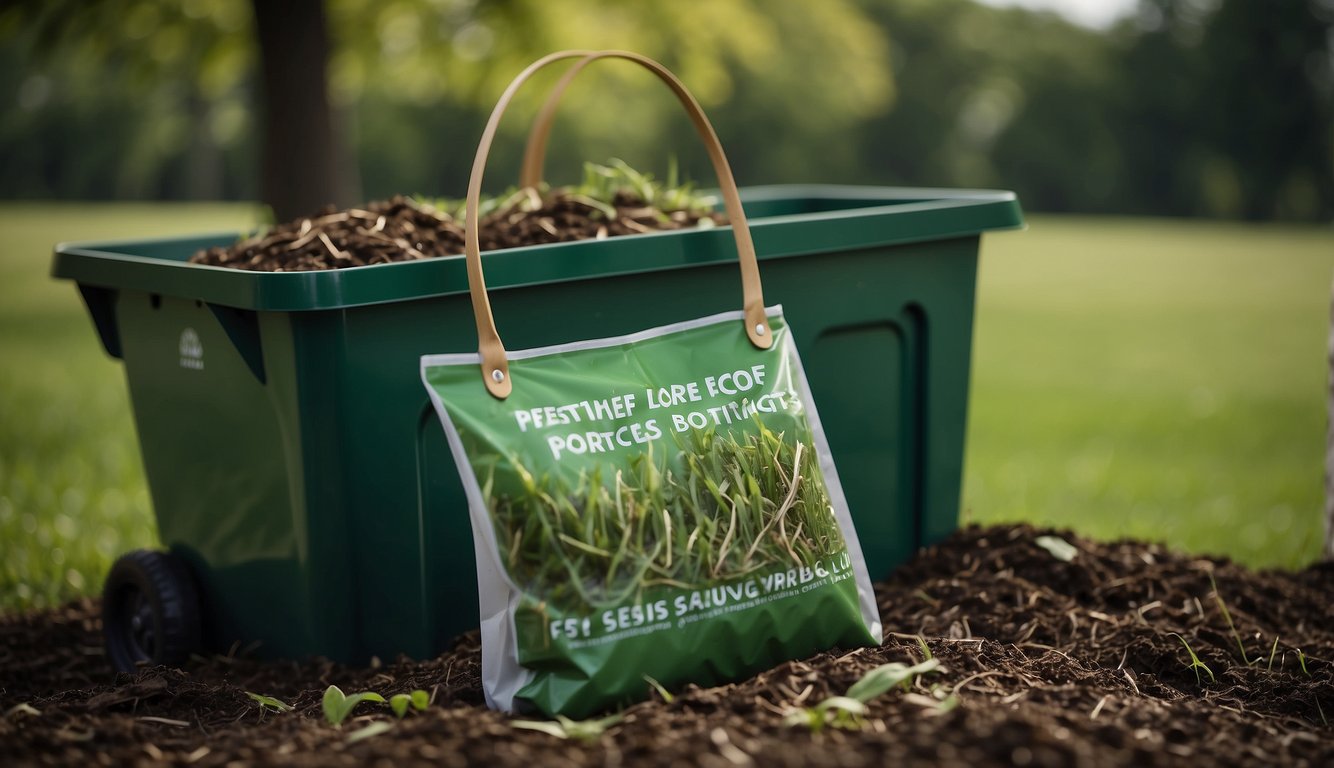
As a responsible homeowner, I understand the importance of maintaining a healthy lawn while minimizing my ecological footprint. Properly disposing of grass clippings is an essential aspect of lawn care that requires eco-friendly practices and environmental considerations. In this section, I will discuss a few ways to dispose of grass clippings while promoting soil health, reducing waste through recycling, and minimizing environmental impact.
Grasscycling for Soil Health – How to Clean Up Grass Clippings?
Grasscycling is an excellent way to promote soil health and reduce waste. It involves leaving grass clippings on the lawn after mowing, allowing them to decompose and return valuable nutrients to the soil. According to Storables, grass clippings are an excellent source of nitrogen, potassium, and phosphorus, which are essential nutrients for plant growth. By grasscycling, I can reduce the amount of fertilizer needed for my lawn, saving time and money while promoting a healthy lawn.
Reducing Waste through Recycling
Another eco-friendly way to dispose of grass clippings is by recycling them. Composting grass clippings is an excellent way to reduce waste while creating nutrient-rich soil. According to YourGreenPal, there are three methods to compost grass clippings: grass cycling, traditional composting, and using grass clippings as mulch in a garden bed. Grasscycling is the easiest method, while traditional composting requires more effort. Using grass clippings as mulch is an excellent way to reduce water usage while promoting soil health.
Minimizing Environmental Impact
Properly disposing of grass clippings is essential to minimize environmental impact. According to Storables, grass clippings can be composted, mulched, or even used as animal feed. By repurposing them, I can support sustainable practices and contribute to a healthier planet. It is essential to follow local regulations and guidelines for grass clippings disposal to avoid environmental damage. By following eco-friendly practices, I can maintain a healthy lawn while minimizing my ecological footprint.
Tools and Equipment for Cleanup – How to Clean Up Grass Clippings?

As someone who has been mowing lawns for years, I know that cleaning up grass clippings can be a hassle. However, with the right tools and equipment, the process can be made much easier. In this section, I’ll cover the tools and equipment you’ll need for cleaning up grass clippings.
Choosing the Right Lawn Mower
The first step in cleaning up grass clippings is to choose the right lawn mower. If you have a lawn mower with a mulching feature, you can skip the cleanup process altogether. Mulching mowers chop the grass clippings into small pieces, which are then distributed back into the lawn. This not only saves time but also provides nutrients to the lawn.
However, if you don’t have a mulching mower, you’ll need to collect the grass clippings after mowing. In this case, you can choose between a bagging mower or a side discharge mower. Bagging mowers collect the grass clippings in a bag, which can be emptied into a compost pile or a yard waste bin. Side discharge mowers, on the other hand, discharge the grass clippings to the side of the mower, which can then be raked up.
Additional Tools for Cleanup – How to Clean Up Grass Clippings?
In addition to a lawn mower, there are a few other tools you’ll need for cleaning up grass clippings. First, you’ll need gloves to protect your hands from any sharp objects that may be hiding in the grass clippings. Second, you’ll need a rake to gather the grass clippings into a pile. A metal rake is the most effective for this task. Finally, you may want to use a leaf blower to blow the grass clippings into a pile or to blow them into a yard waste bin.
In summary, choosing the right lawn mower and having the right tools and equipment can make cleaning up grass clippings a breeze. If you have a mulching mower, you can skip the cleanup process altogether. If not, a bagging or side discharge mower, gloves, a rake, and a leaf blower are all you need to get the job done.
Enhancing Aesthetic Appeal and Property Value
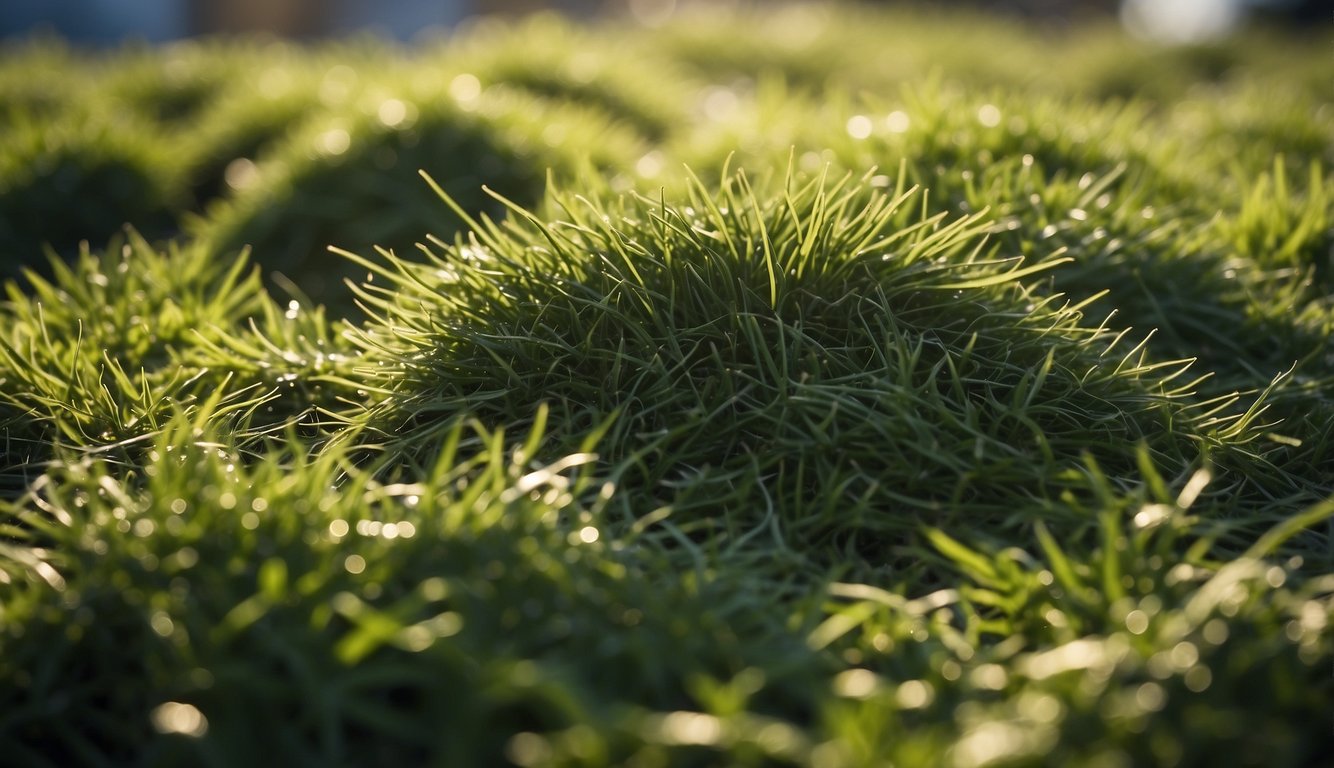
As a homeowner, I understand that maintaining the aesthetic appeal of my property is crucial for its overall value. One of the ways to achieve this is by cleaning up grass clippings after mowing. Not only does this promote cleanliness, but it also enhances the visual appeal of the lawn.
Visual Appeal through Cleanliness – How to Clean Up Grass Clippings?
A clean and well-maintained lawn can significantly improve the overall look of a property. By removing grass clippings promptly, you can prevent the formation of unsightly clumps that detract from the lawn’s pristine appearance. Additionally, regular cleaning of grass clippings can prevent the growth of weeds and pests, which can damage the lawn and reduce its visual appeal.
Landscaping and Lawn Maintenance
Effective landscaping and lawn maintenance are essential for enhancing the aesthetic appeal of a property. Regular lawn maintenance, including mowing, watering, and fertilizing, can promote healthy grass growth, resulting in a lush and green lawn. Additionally, proper landscaping can create a visually appealing outdoor space, which can significantly improve the overall value of a property.
Maintaining the cleanliness of a lawn by cleaning up grass clippings after mowing is an essential step towards enhancing the aesthetic appeal and overall value of a property. By combining effective landscaping and lawn maintenance practices, homeowners can create a visually appealing outdoor space that not only looks great but also adds value to their property.
How to Clean Up Grass Clippings
Today, we’re tackling the age-old question – how to clean up grass clippings? Buckle up, it’s going to be a green ride!
Firstly, let’s talk about raking. It’s the old-school method, but it works! Just grab a rake and gather those clippings into a pile. It’s like a mini workout!
Next, the lawn sweeper. This handy tool sweeps up your clippings in a jiffy. It’s like a vacuum cleaner for your lawn!
And here’s a fun fact! Grass clippings can be composted. They’re rich in nitrogen and break down quickly. It’s like turning waste into garden gold!
So, next time you’re faced with a lawn full of clippings, don’t despair. You’ve got this!
For more lawn care tips, do visit the website theherbprof.com. Keep it green, folks!
References – How to Clean Up Grass Clippings?
Little Herb Encyclopedia, by Jack Ritchason; N.D., Woodland Publishing Incorporated, 1995
The Ultimate Healing System, Course Manual, Copyright 1985, Don Lepore
Planetary Herbology, Michael Tierra, C.A., N.D., Lotus Press, 1988
Handbook of Medicinal Herbs, by James A. Duke, Pub. CRP Second Edition 2007
The Complete Medicinal Herbal, by Penelope Ody, Published by Dorling Kindersley
Check the Following Articles!
Weird Green Vegetables: Uncommon but Nutritious
Geranium Aroma: Benefits and Uses in Aromatherapy
Diatomaceous Earth Wet: How to Use and Apply It Safely
Frequently Asked Questions – How to Clean Up Grass Clippings?
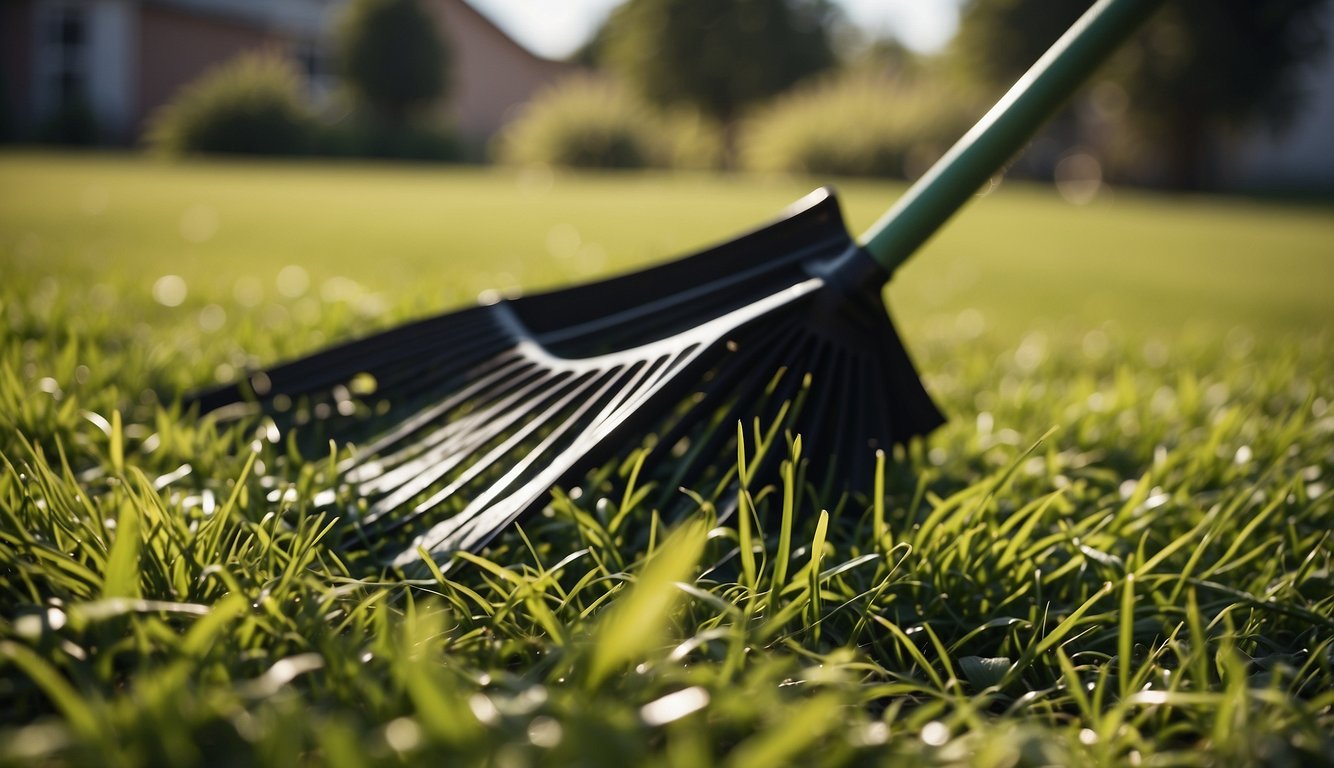
What is the most efficient method for removing grass clippings from a sidewalk?
The most efficient method for removing grass clippings from a sidewalk is to use a leaf blower. A leaf blower can quickly blow the grass clippings off the sidewalk and onto the lawn or into a bag. If you do not own a leaf blower, a broom or rake can also be used to sweep or rake the clippings off the sidewalk.
How can excess grass clippings be managed on a lawn without causing damage?
Excess grass clippings can be managed on a lawn without causing damage by using a mulching mower. A mulching mower chops the grass clippings into small pieces and deposits them back onto the lawn, where they decompose and provide nutrients to the soil. If the grass is too long to mulch, it is best to mow the lawn more frequently to avoid leaving large clumps of grass clippings on the lawn.
What are the best practices for disposing of grass clippings after lawn mowing?
The best practice for disposing of grass clippings after lawn mowing is to compost them. Grass clippings are a great source of nitrogen for compost and can help create a nutrient-rich soil amendment. If you do not compost, grass clippings can also be used as a mulch around trees, shrubs, and garden beds.
Can grass clippings be included in regular household waste?
Grass clippings should not be included in regular household waste. Grass clippings are considered organic waste and should be composted or recycled. In some areas, grass clippings can be collected by the city or county and turned into compost or mulch.
What are some effective tools for picking up grass clippings?
Some effective tools for picking up grass clippings include a lawn sweeper, a bagging mower, or a rake. A lawn sweeper is a machine that picks up grass clippings and other debris from the lawn and deposits them into a bag. A bagging mower is a mower that collects grass clippings in a bag attached to the mower. A rake can also be used to pick up grass clippings, but it is more time-consuming than using a machine.
Are there any creative uses for bagged grass clippings?
Yes, there are several creative uses for bagged grass clippings. Grass clippings can be used as a mulch around trees, shrubs, and garden beds. They can also be used as a weed barrier in garden beds or as a natural fertilizer for plants. Additionally, grass clippings can be used to create a compost pile or added to an existing compost pile to provide nitrogen.
